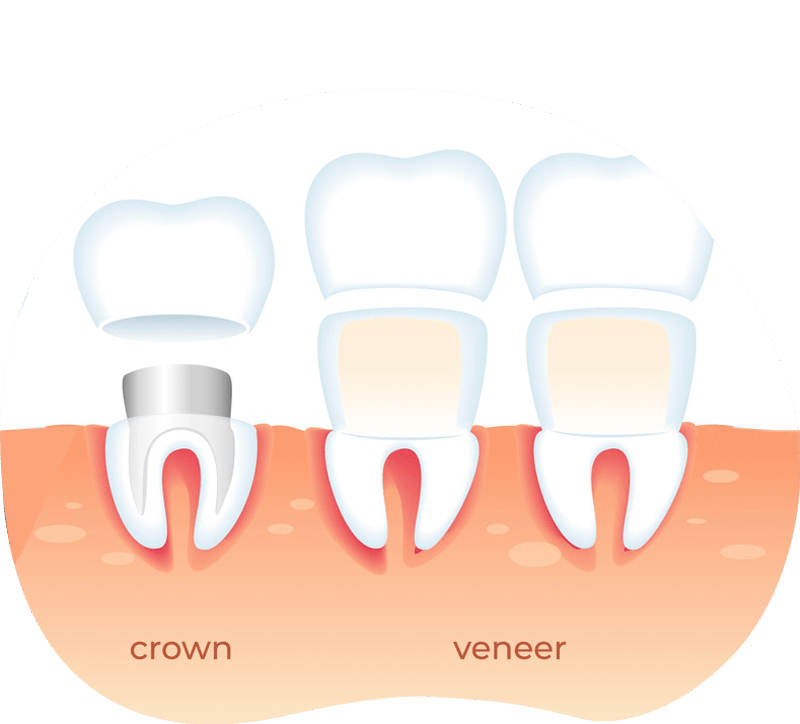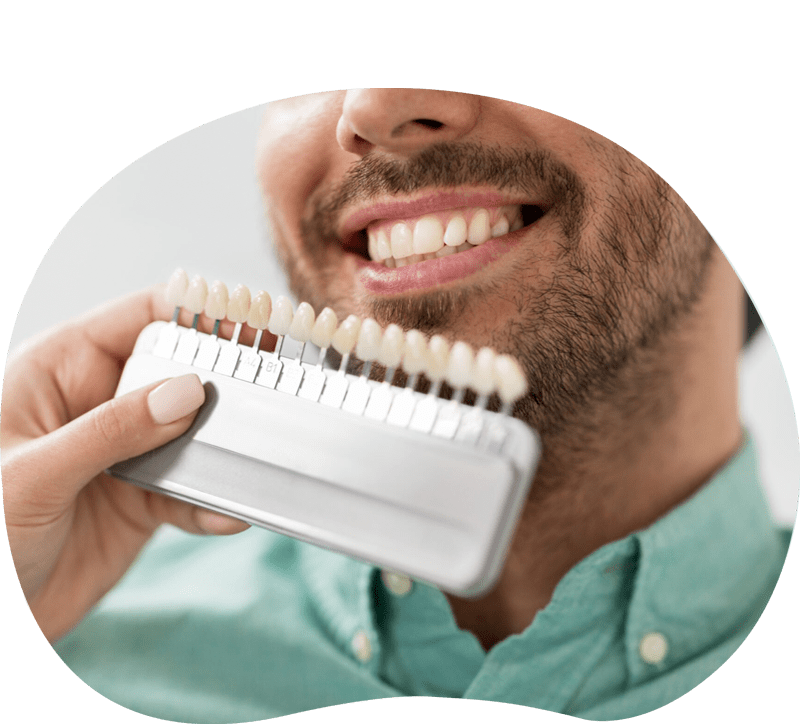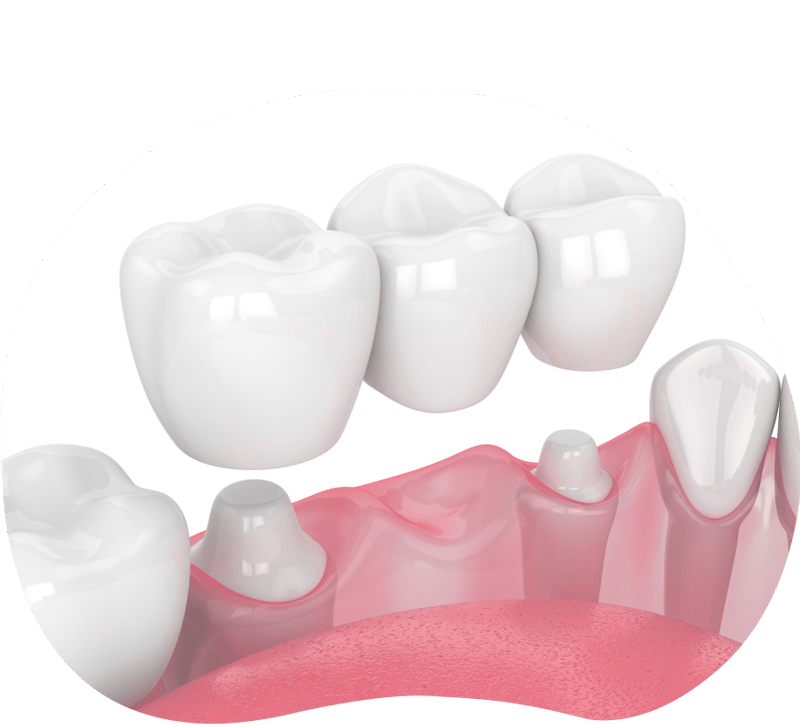Hollywood Smile
Our teeth are the jewelry of the face and should have a natural and healthy look.
Our teeth, gum, lips, and the harmony of all these units are defined as “Smile Design”. The objective of this treatment is perfecting the tooth shape and correcting the tooth color problems.
The most popular Hollywood smile cosmetic treatments include veneers or crowns, implants, and teeth whitening. Often an esthetic gum surgery may be required to change the gum margins and align them to match your new smile.
Supportive dental treatments such as root canal therapy, composite filling, and tooth removal are also available to make the oral condition as healthy as needed for the smile makeover process and to ensure that there is no problem to be treated prior to the process. As each person is being unique, each smile design needs to be unique and therefore customized to the facial features of the patient.

Creating the Right Smile Design
Step 1: Oral health check
During the first consultation, a comprehensive dental examination -including but not limited to dental radiographs and a meticulous clinical examination of the teeth and surrounding tissues- is conducted, and if necessary a diagnosis and treatment plan is prepared. The doctor’s planning of the patient’s treatment will take shape according to these analyses.
Step 2: Aesthetic procedure
Aesthetic procedure starts with learning and understanding the patient’s vision and imagination for the smile design during the consultation. The result can only be defined as a “success” if the result of the smile design matches the patient’s imagination and vision. Patient’s professional dental pictures and videos are taken. This is followed by the creation of initial impressions of all teeth.
In order to achieve the highest success rate, we use Cad-Cam systems digital workflows, newly developed systems for dentistry. Impressions are taken digitally using a special 3D camera, and restorations are designed on a 3D software and created by special machines which ensure that your dental prostheses are not only beautiful but they also fit your teeth perfectly.
Step 3: Prototype creation
At this stage the dentist and the dental technician create the prototype of the new smile design in the dental laboratory.
Prototype of the new smile is transferred to the patient’s teeth at the second appointment without performing any drilling. By this way, the patient is able to visualize the new smile design and see it first hand even before starting the treatment.
At this stage the last detailed corrections are also made and length and shape corrections are finalized. Impressions are taken, and the session ends with fixing of temporary laminates.
Step 2: Aesthetic procedure
Aesthetic procedure starts with learning and understanding the patient’s vision and imagination for the smile design during the consultation. The result can only be defined as a “success” if the result of the smile design matches the patient’s imagination and vision. Patient’s professional dental pictures and videos are taken. This is followed by the creation of initial impressions of all teeth.
In order to achieve the highest success rate, we use Cad-Cam systems digital workflows, newly developed systems for dentistry. Impressions are taken digitally using a special 3D camera, and restorations are designed on a 3D software and created by special machines which ensure that your dental prostheses are not only beautiful but they also fit your teeth perfectly.
Step 3: Prototype creation
At this stage the dentist and the dental technician create the prototype of the new smile design in the dental laboratory.
Prototype of the new smile is transferred to the patient’s teeth at the second appointment without performing any drilling. By this way, the patient is able to visualize the new smile design and see it first hand even before starting the treatment.
At this stage the last detailed corrections are also made and length and shape corrections are finalized. Impressions are taken, and the session ends with fixing of temporary laminates.
Step 4: Installation
At this final stage (during the 3rd appointment) the dentist cleans the surface of the teeth, trims part of the enamel and adds special adhesive to bind the teeth and porcelain restorations together, finalizing the treatment and giving you the smile of your dreams.

Techniques used in Hollywood Smile Restoration
Our genetics largely determine the shade and shape of our teeth. But, aesthetic and restorative dentistry has combined art and science to create a world of possibilities to restore your smile and confidence.
The most common dental methods that can improve the look and function of your teeth are veneers and crowns. Both alternatives can achieve great results; however, there are some key differences between them, which means it is important to choose the right option for your particular situation. In summary:
Veneers: | Crowns: |
Covers only the front of your tooth. | Covers the entire tooth. |
Less of the tooth needs to be removed: about 0.4mm to 0.7mm. | Between 60% and 75% of the existing visible tooth to be trimmed. |
A great choice for badly stained teeth, chipped teeth, minor cracks in teeth, small gaps between the teeth, and superficial misalignment. | Needed when there are fundamental issues: badly broken or cracked teeth, where root canal treatment has been needed, the edge of the tooth has been damaged by grinding. |
Materials used in Hollywood Smile Restoration
At Estheticalia Dental, we use the highest quality materials for restoring your smile and dental health.
That is why we choose the Emax®️ Laminate Veneers and Crowns for restoring your teeth. The Emax®️ Laminate Veneers and Crowns are one of the strongest, esthetically beautiful and durable porcelain prostheses used by leading cosmetic dentists throughout the world for creating beautiful smiles.
E-max®️ Laminate Veneers
- A dental veneer is a thin porcelain overlay that covers the external tooth surface.
- Crafted from lithium disilicate glass-ceramic, Emax®️ Laminate Veneers is one of the most aesthetically pleasing options, creating incredible translucency and a very realistic looking tooth that matches with other natural teeth.
- Less of the tooth needs to be removed: about 0.4mm to 0.7mm.
- They are lighter and thinner than other dental porcelains.
- They are also substantially stronger.
- Look very natural thanks to their translucency and high light reflection properties.
- Veneers are bonded to the surface of a tooth using a special adhesive to
- Repair broken or chipped / cracked teeth,
- Eliminate extensive discoloration, uneven coloring or hereditary discoloration of teeth when whitening / bleaching does not give intended results,
- Reform the smaller-than-average teeth or unusually shaped teeth,
- Close the minor gaps in the teeth.
- Veneers can be installed on the entire dentition.
- The procedure is painless.
- They are a non-allergic and tissue-friendly material.
- It does not cause a gum recession.
- It does not cause any taste change or oral malodor.
- They are permanent: With proper care, they can last 10 to 15 years, but you still need to care for them as you would care for your natural teeth.
- After the treatment you can wash, floss, eat, and talk normally.


E-max®️ Laminate Veneers
- A dental crown is like a cap that covers the entire tooth.
- It requires 60% to 75% of the existing teeth to be trimmed.
- Some of the biggest advantages of zirconia are its strength and durability.
- It has very high heat isolation characteristics; it prevents tooth sensitivity against cold and hot.
- With its light transmission characteristics, the texture of natural teeth is achieved.
- As with veneers, crowns are bonded to your teeth to:
- It does not cause a gum recession.
- It does not cause any taste change or oral malodor.
- It does not cause allergic reactions because it does not contain any metals.
Differences between E-max®️ Laminate Crowns and Zirconia Crowns
E-max®️ is a lithium disilicate glass. It’s an all-ceramic material made from quartz, lithium dioxide, phosphorus oxide, alumina, potassium oxide, and other components. | Zirconia crowns are made from zirconium dioxide, a very durable type of metal that’s related to titanium, although it’s categorized as a type of ceramic crown. |
E-max®️ crowns are more translucent. E-max®️ is known for having a naturally translucent appearance that allows light through just like natural teeth. | Multi-layered zirconia crowns can achieve an impressive translucency but the transmittance values of these materials still do not match lithium disilicate. |


